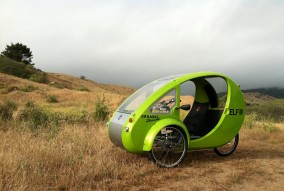Transforming Energy Use in New England
- Article Published At:
- Green Energy Times
- Date of Publication:
- June 18th, 2016
It has been an unusual spring. After a warm winter, the early daffodils bloomed in late March here in Vermont, but their blooms were killed by a very heavy frost in April. But spinach and lettuce that overwintered survived that severe frost, and so did hardy seeds including peas that I planted around the beginning of April. As a gardener I adapt to change.
Awareness is spreading in New England that our entire energy system must change, so what do we need to do? We know how to retrofit our houses so that it take less energy to heat them in winter. Energy teams can go through your home and add insulation, seal up the doors and replace old windows. I was pleasantly surprised how comfortable my old house on a hill became without drafts! We know how to build net-zero houses for new construction – essentially buildings that are so well sealed that that they use air-to-air heat exchangers to ventilate the home, and transfer heat from exhaust air to the cold incoming air in winter.
The transformation of our electrical energy system to renewables is under way. Solar panels on houses, shared community solar arrays, and many multi-megawatt arrays are feeding the grid. I now enjoy looking at my electric bill every month, and seeing the large credit from the 5kW of solar power that I purchased from a community array. Electrical storage for the grid is about to take off with the rapid fall in the price of batteries driven by the electric car firms like Tesla. Much of what is needed could be largely completed in less than ten years if we made the effort. Yes, complaints are increasing from those that don’t like to see solar panels everywhere, but the long-term benefit to society and the Earth is immeasurable. We could do better with more thoughtful community planning, but US society has traditionally preferred the freedom of this somewhat chaotic entrepreneurial growth.
It is time to tackle transportation, which uses so much fossil fuel both in a rural states and in urban areas. Industry would like us to buy a lot of electric cars, so we can continue to commute alone. Electric cars with a 200-mile range at a reasonable cost should be available by the end of this year, and they will help. But we should think about how to start the shift from using heavy single-occupancy-vehicles to get around. We have not made a change this big for a century, when trains and then automobiles replaced horse and buggy.
Uber has shown how taxi services can be improved by networking. Now we need networked passenger vans and private cars on our highways, so that I can easily share rides between my home in Pittsford and Burlington. It seems that this would not be difficult to set up. China is leap-frogging over Uber, and developing a broad Web-linked transportation system.
Another revolution would be light-weight electric vehicles, derived from tricycles, rather than cars. Add an all-weather aerodynamic shell, and with only 10 percent of the weight of a car, it is much easier to get adequate range using lithium batteries. Yes, commuting would be a little slower, as they are currently limited to about 20 mph, unless the rider pedals as well, when they can go faster. However, the cost in both dollars and damage to the Earth is far less.
One fringe benefit of using an electric trike to commute would be that exercise improves health and productivity. Our sedentary existence is a huge drain on our physical energy and medical finances. We should start planning and building a real bike networks in our cities and across New England, so these light-weight efficient vehicles do not have to share the highways with trucks. In Europe, Germany has started down this path.
Globally, tens of millions of electrical bicycles and tricycles are now sold annually, but this county is largely ignoring this shift. We dream of ‘solving’ climate change without really changing the way of life that created it!
Related Topics
Figures and Images
 Figure 1: Electric-assist tricycle with solar panel on roof. (OrganicTransit.com)Electric-assist tricycle with solar panel on roof
Figure 1: Electric-assist tricycle with solar panel on roof. (OrganicTransit.com)Electric-assist tricycle with solar panel on roof